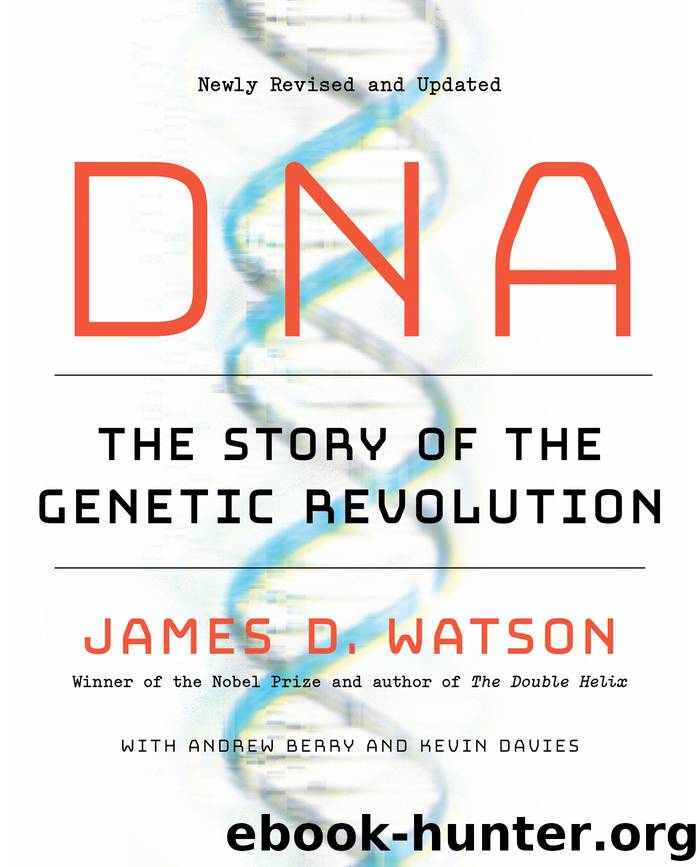DNA: The Story of the Genetic Revolution by James D. Watson & Andrew Berry & Kevin Davies

Author:James D. Watson & Andrew Berry & Kevin Davies
Language: eng
Format: epub
Publisher: Knopf
Published: 2017-08-22T04:00:00+00:00
Cell division: A cell’s chromosomes (blue) are duplicated and then lined up along a special “spindle” (green) prior to being assigned to each daughter cell. High-tech imaging techniques help bring to life the extraordinary chromosomal waltz underpinning life’s ability to perpetuate itself.
The fly has, of course, been the focus of intensive genetic investigation ever since its adoption by T. H. Morgan, and through the ensuing years of continual innovation Drosophila melanogaster has remained a genetic gold mine. In the late 1970s at the European Molecular Biology Laboratory in Heidelberg, Germany, Christiane “Janni” Nüsslein-Volhard and Eric Wieschaus undertook a spectacularly ambitious fruit fly project. They used chemicals to induce mutations and then looked for disruptions in the very early embryonic stages of the flies’ progeny. Classically, the quarry of the fruit fly geneticist was mutations affecting adults, like the one Morgan found to produce white (rather than red) eyes. In focusing on embryos, Nüsslein-Volhard and Wieschaus were not only condemning themselves to years of eyestrain as they stared down microscopes in pursuit of those elusive mutants, they were also venturing into utterly uncharted territory. The payoff, however, was spectacular. Their analysis uncovered several suites of genes that lay out the fundamental body plan of the developing fly larva.
The more universal message of their work is that genetic information is hierarchically organized. Nüsslein-Volhard and Wieschaus noticed that some of their mutants showed very broad effects while others evinced more restricted ones; from this they inferred correctly that the broad-effect genes operate early in development—at the top of a switching hierarchy—while the restricted-effect genes operated later. What they had found was a cascade of transcription factors: genes switching on other genes that in turn switch on others still, and so on. Indeed, hierarchical gene switching of this kind is the key to the construction of complex bodies. A gene producing the biological equivalent of a brick will, left to its own devices, produce a pile of bricks; with proper coordination, however, it can produce a wall, and ultimately a building.
Normal development depends on cells “knowing” where they are in a body. A cell in the tip of a fly’s wing, after all, should develop along very different lines than one located in the region that will give rise to the fly’s brain. The first piece of essential positional information is the simplest: How does the developing fruit fly embryo know which end is which? Where should the head go? Bicoid, a protein produced by a gene in the mother, is distributed in varying concentrations through the embryo. The effect is called a concentration gradient: the protein levels are highest at the head end and fall off as you travel toward the rear. Thus the bicoid concentration gradient instructs all cells within the embryo as to where they fall on the head-to-tail axis. Fruit fly development is segmental, meaning that the body is organized into compartments, all of which have much in common but each of which has some features unique to it. In
Download
This site does not store any files on its server. We only index and link to content provided by other sites. Please contact the content providers to delete copyright contents if any and email us, we'll remove relevant links or contents immediately.
Sapiens: A Brief History of Humankind by Yuval Noah Harari(14311)
Sapiens by Yuval Noah Harari(5321)
Pale Blue Dot by Carl Sagan(4949)
Homo Deus: A Brief History of Tomorrow by Yuval Noah Harari(4870)
Livewired by David Eagleman(3726)
Origin Story: A Big History of Everything by David Christian(3665)
Brief Answers to the Big Questions by Stephen Hawking(3392)
Inferior by Angela Saini(3293)
Origin Story by David Christian(3169)
Signature in the Cell: DNA and the Evidence for Intelligent Design by Stephen C. Meyer(3097)
The Gene: An Intimate History by Siddhartha Mukherjee(3073)
The Evolution of Beauty by Richard O. Prum(2962)
Aliens by Jim Al-Khalili(2801)
How The Mind Works by Steven Pinker(2769)
A Short History of Nearly Everything by Bryson Bill(2656)
Sex at Dawn: The Prehistoric Origins of Modern Sexuality by Ryan Christopher(2500)
From Bacteria to Bach and Back by Daniel C. Dennett(2462)
Endless Forms Most Beautiful by Sean B. Carroll(2442)
Who We Are and How We Got Here by David Reich(2416)
